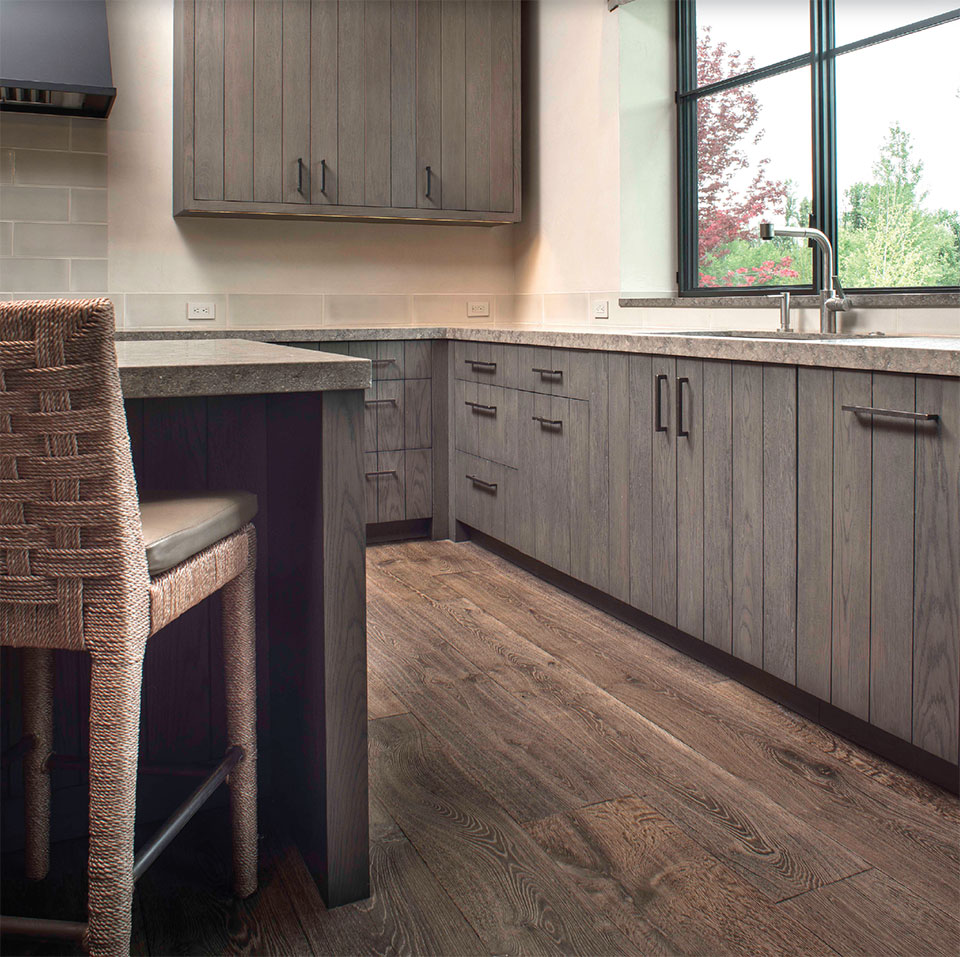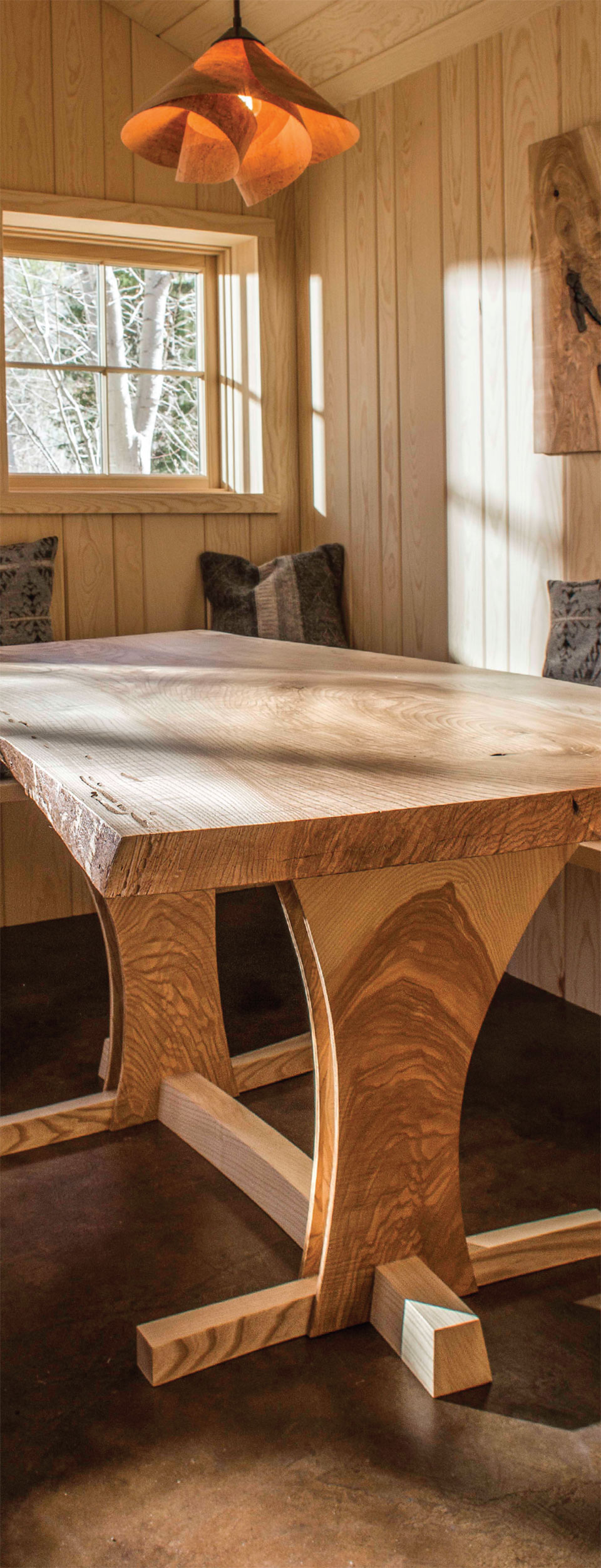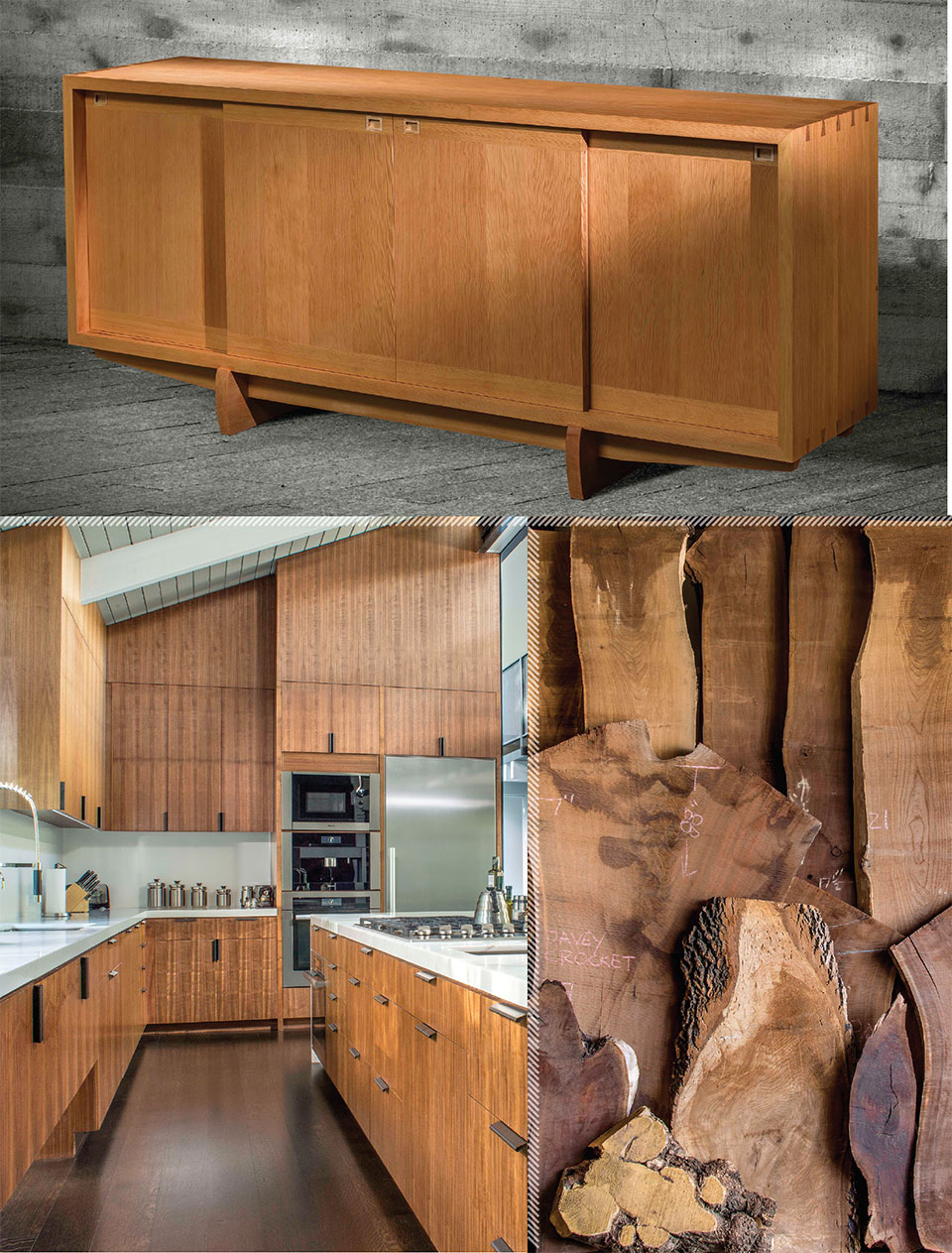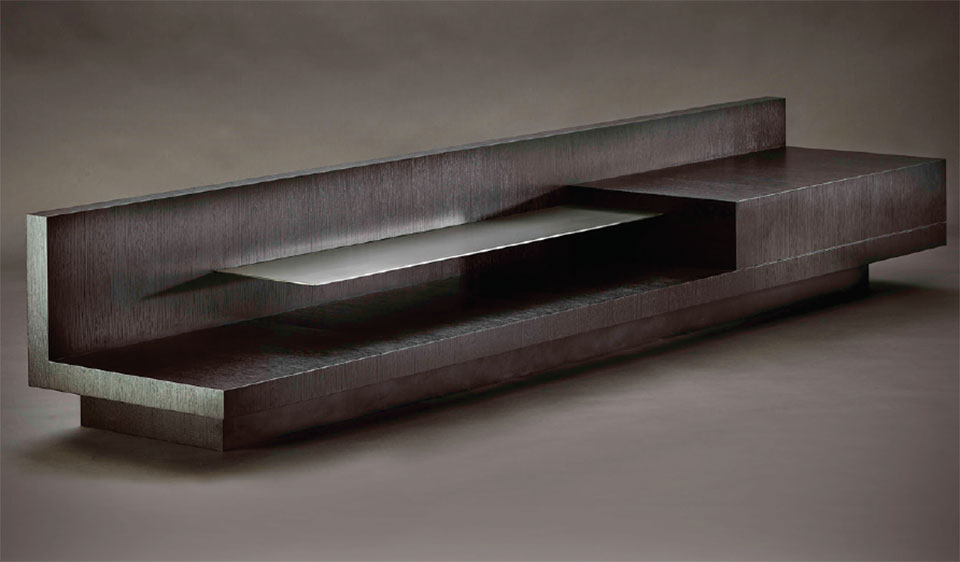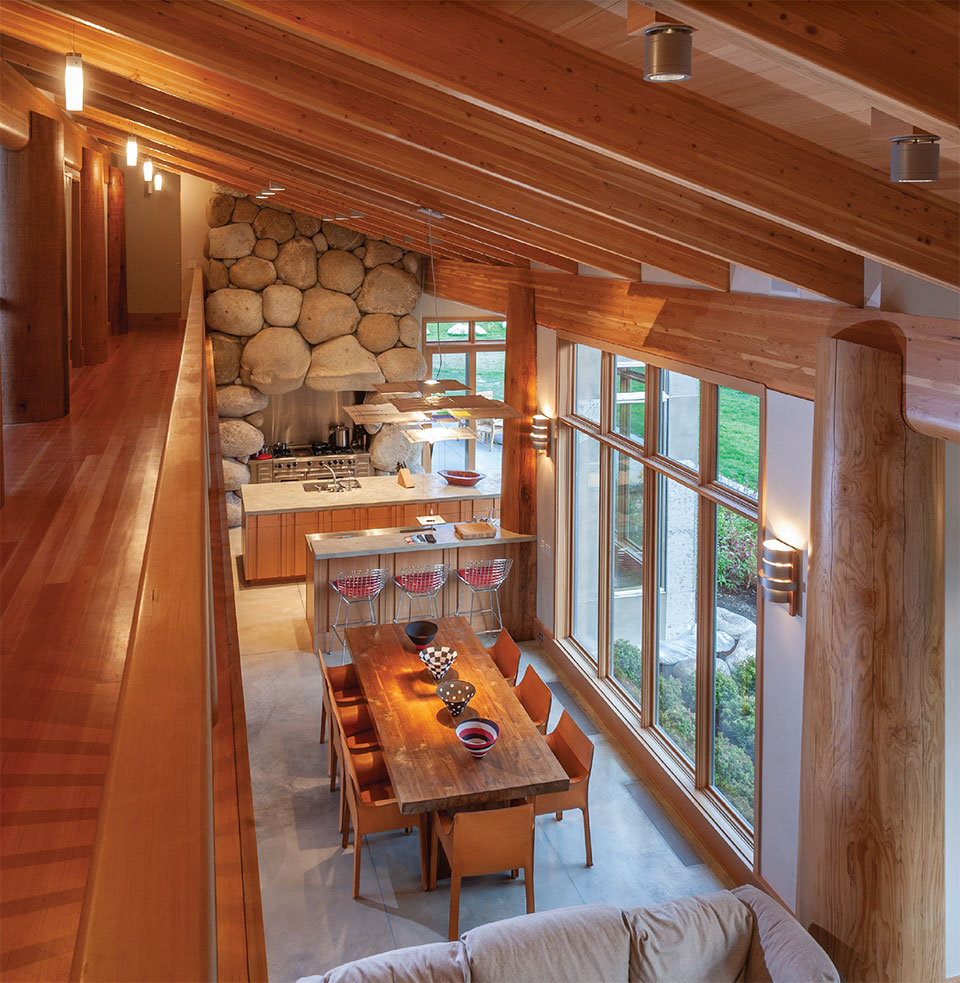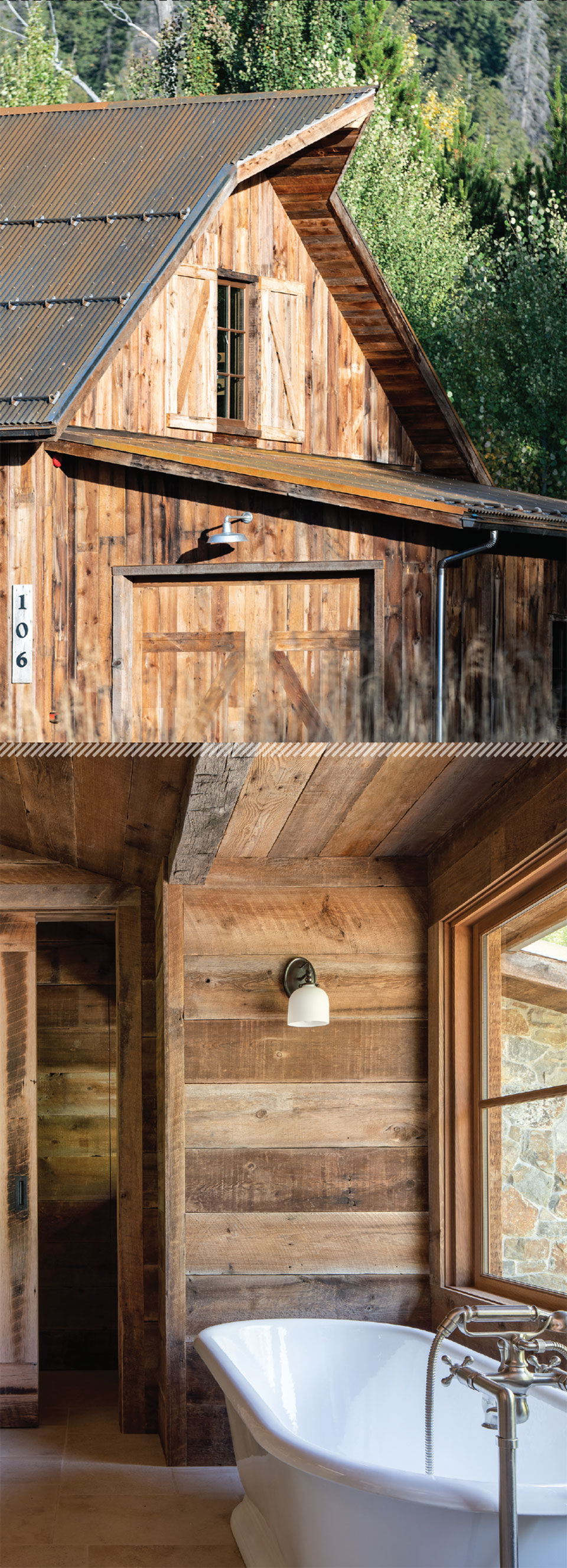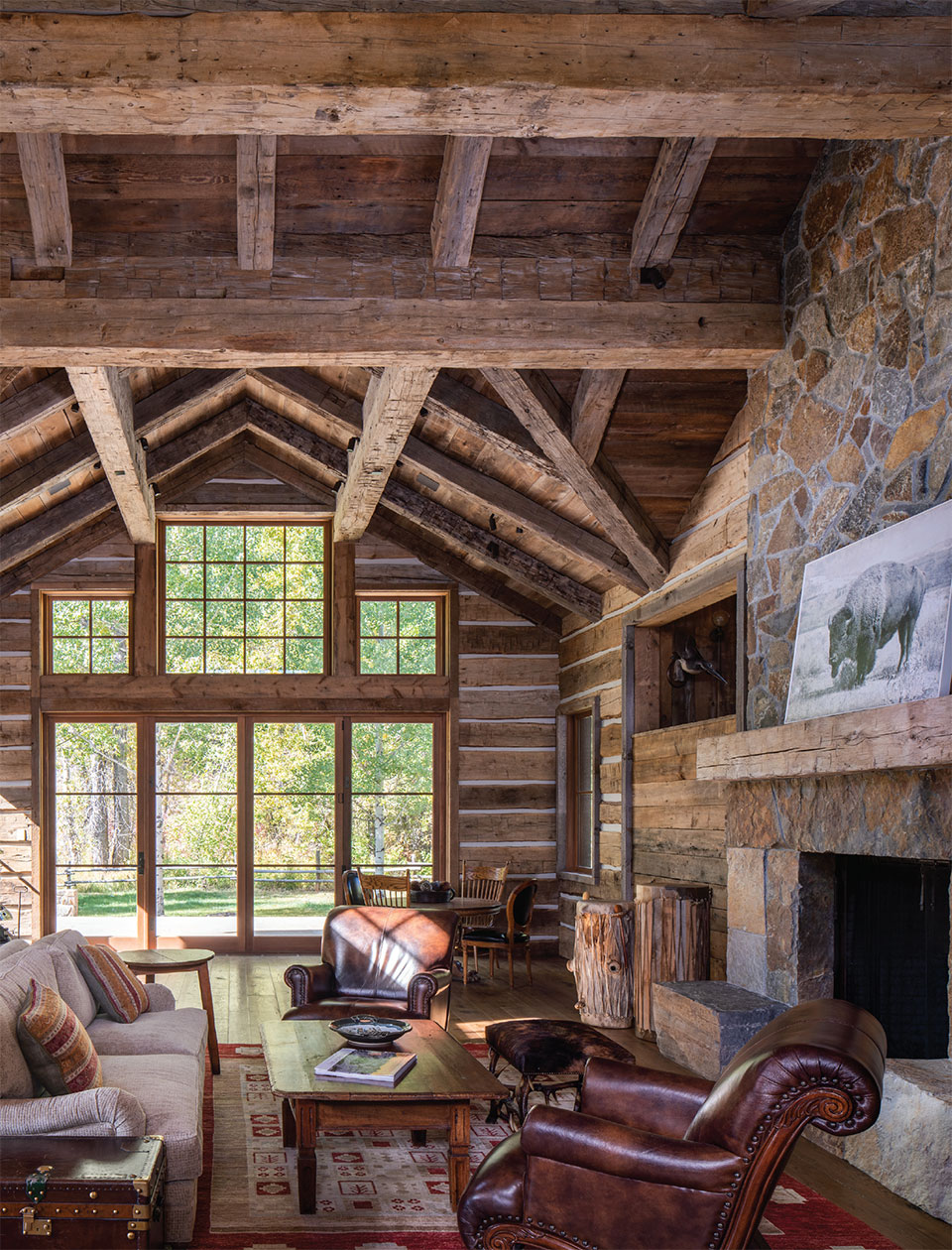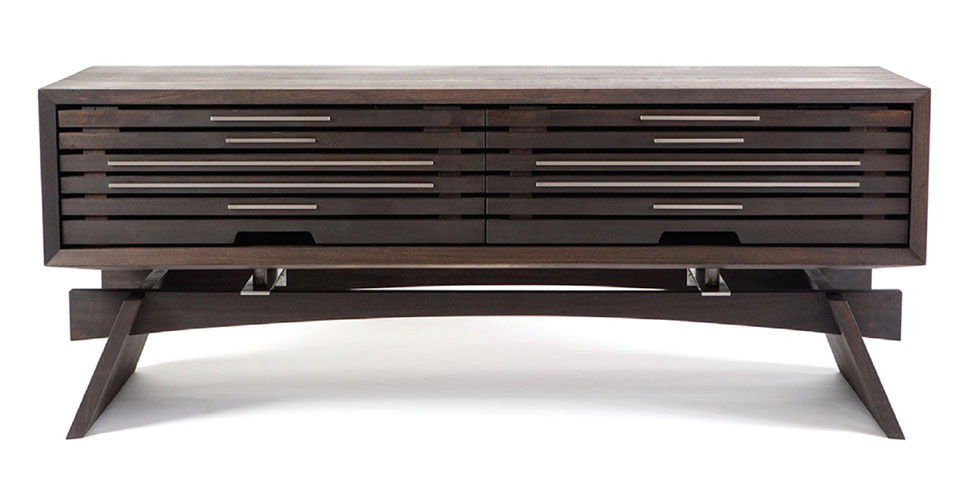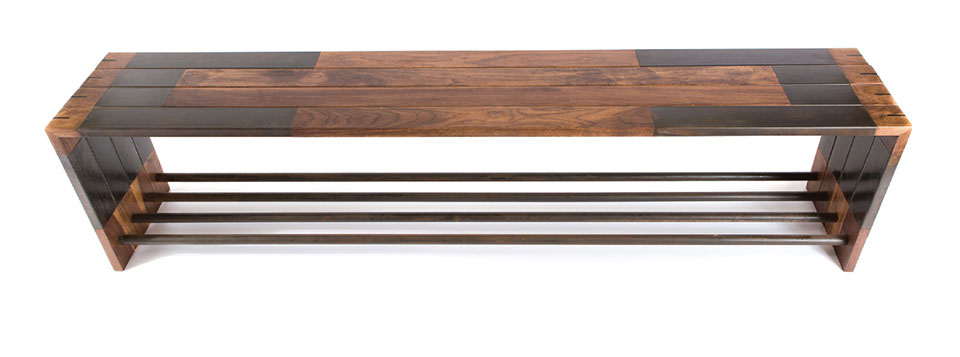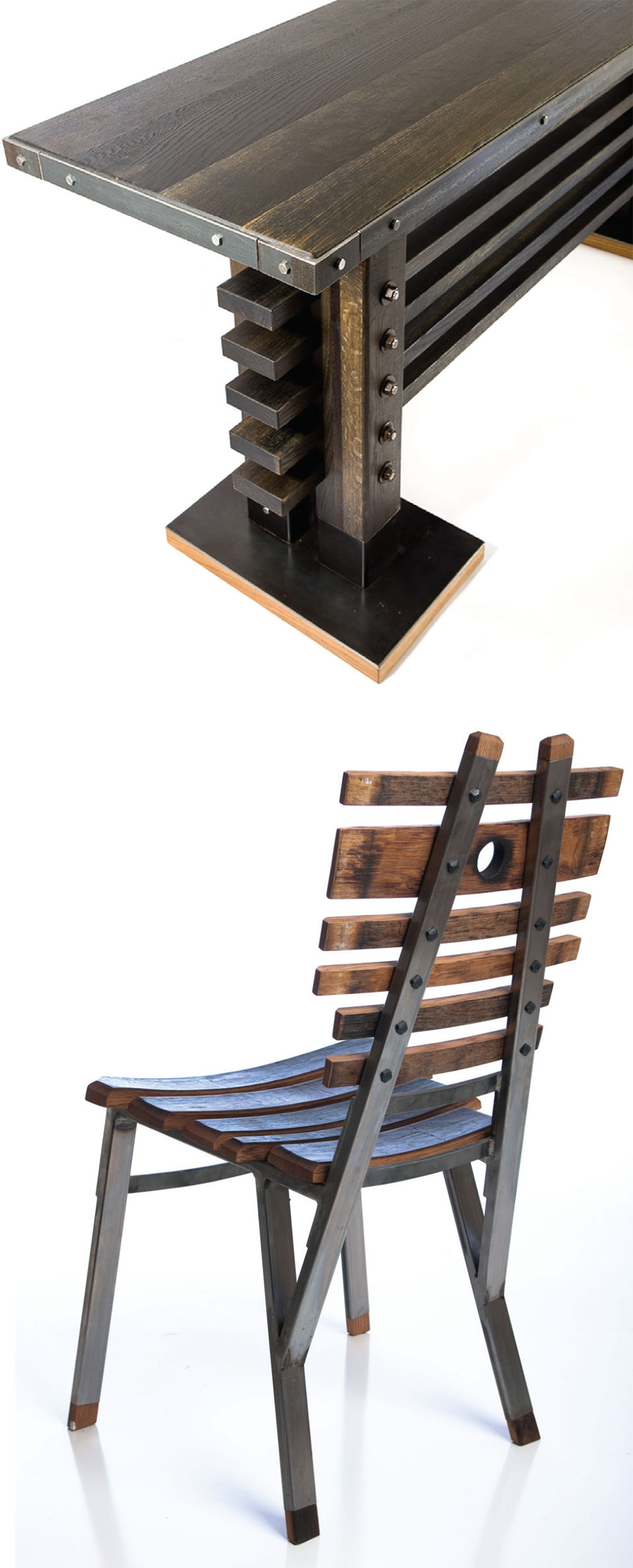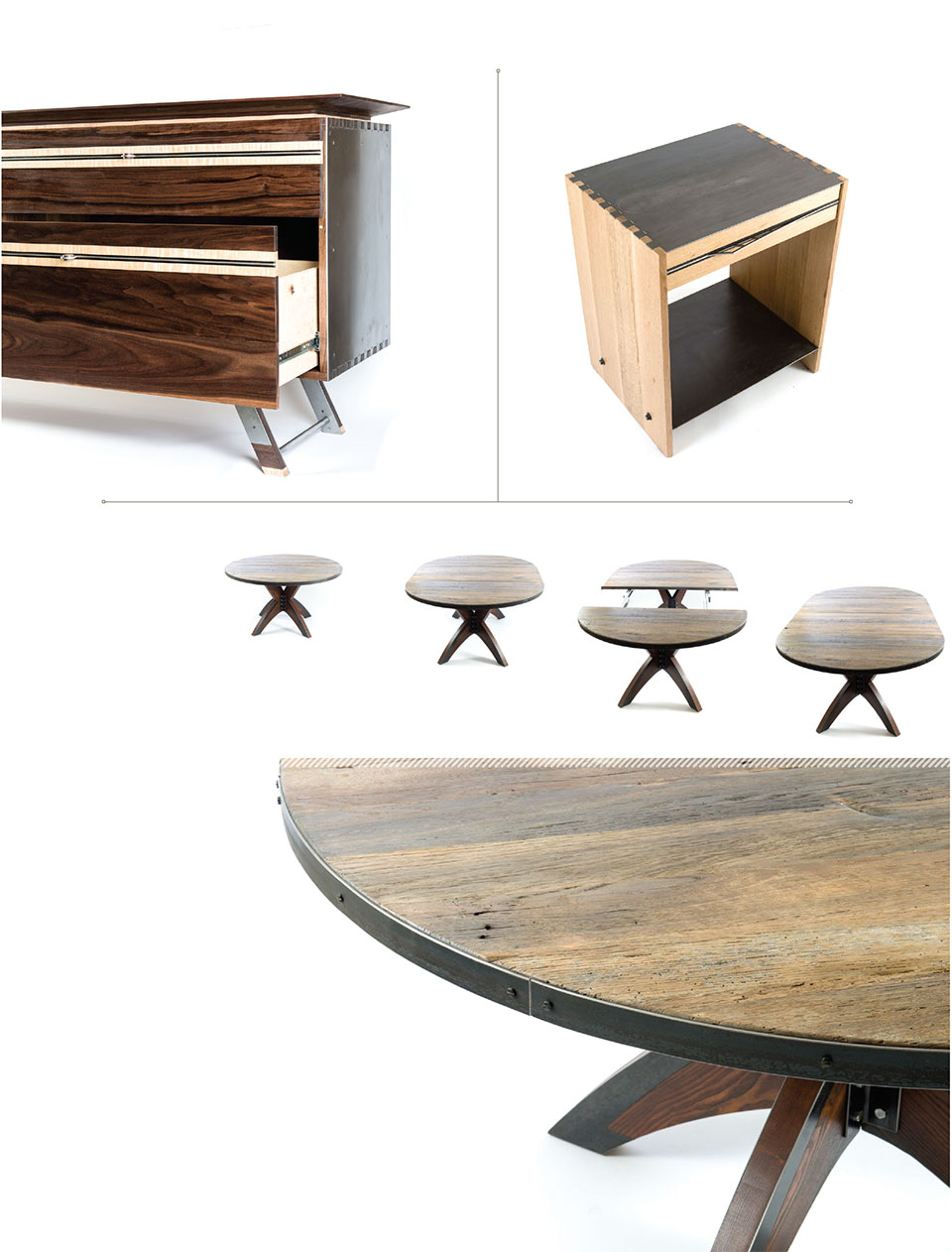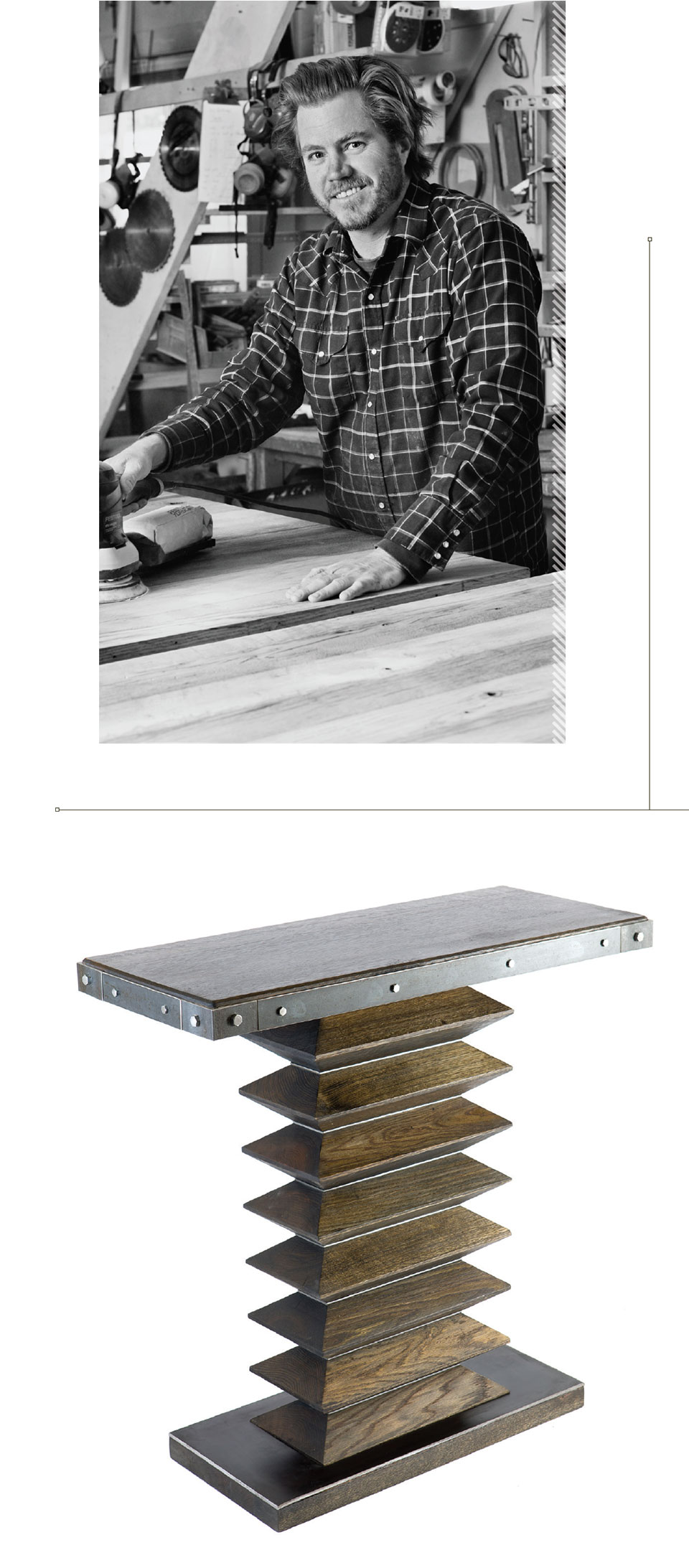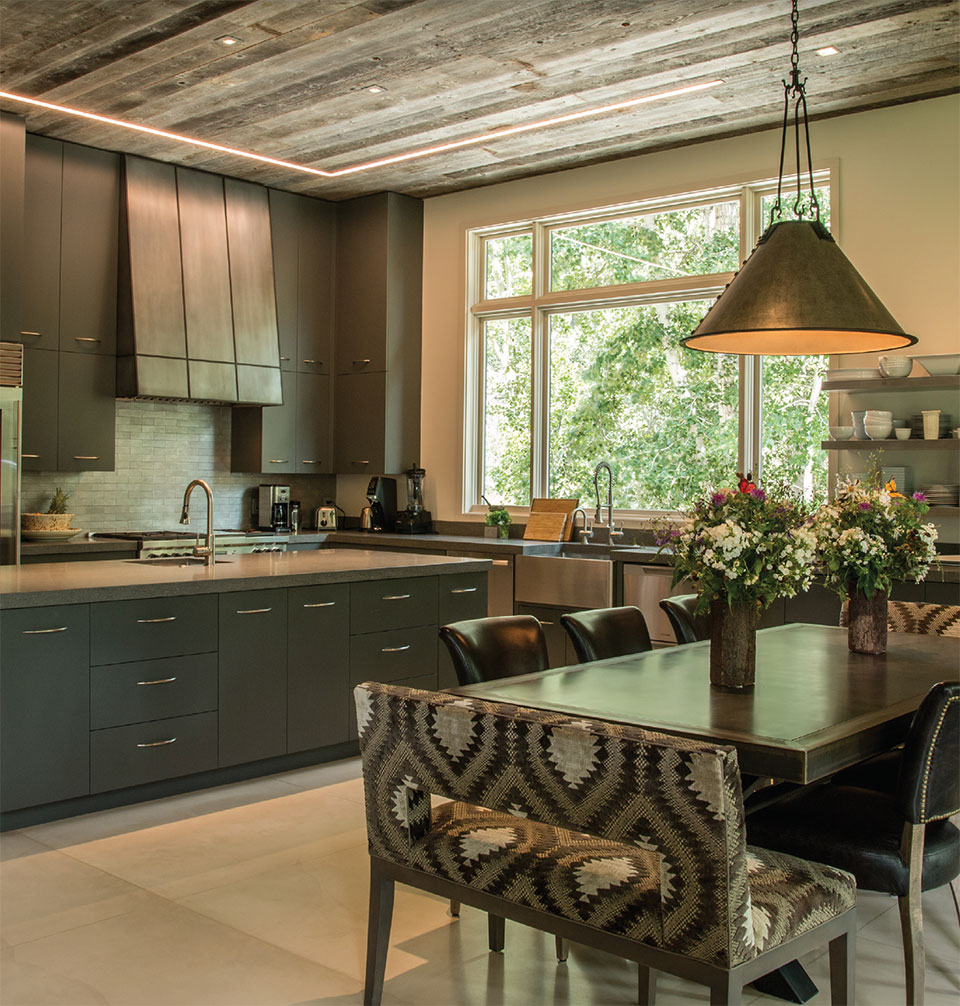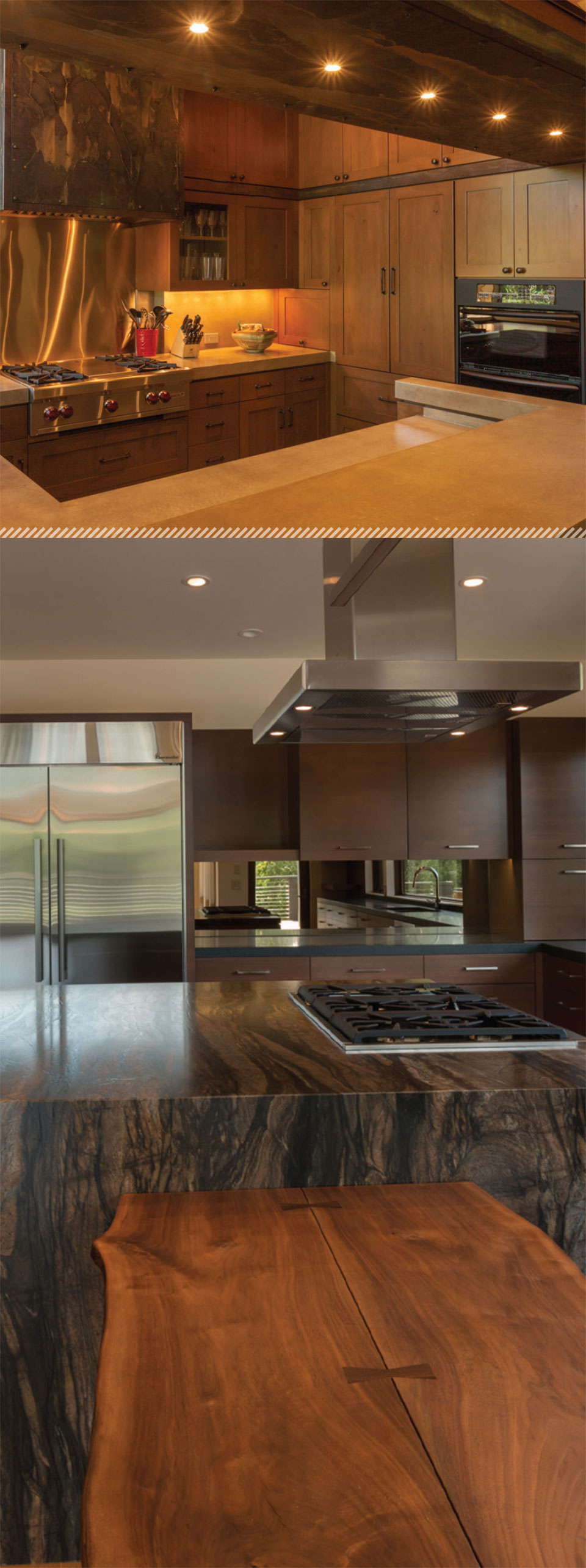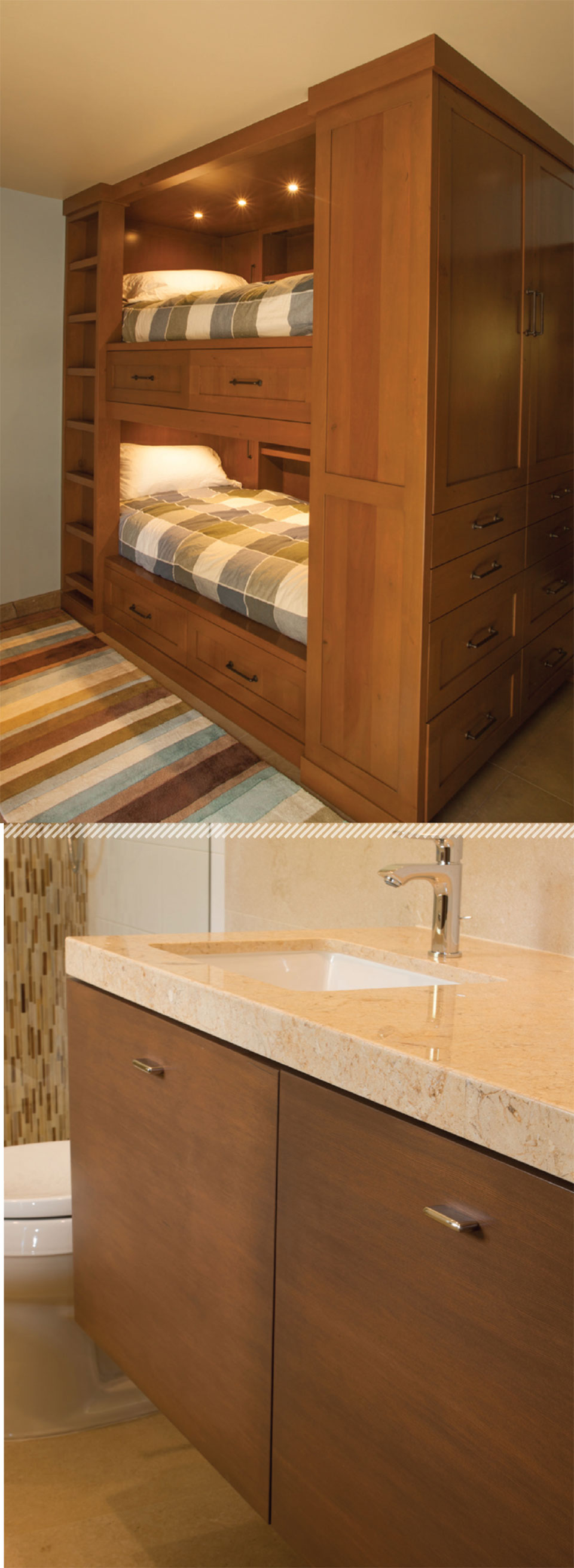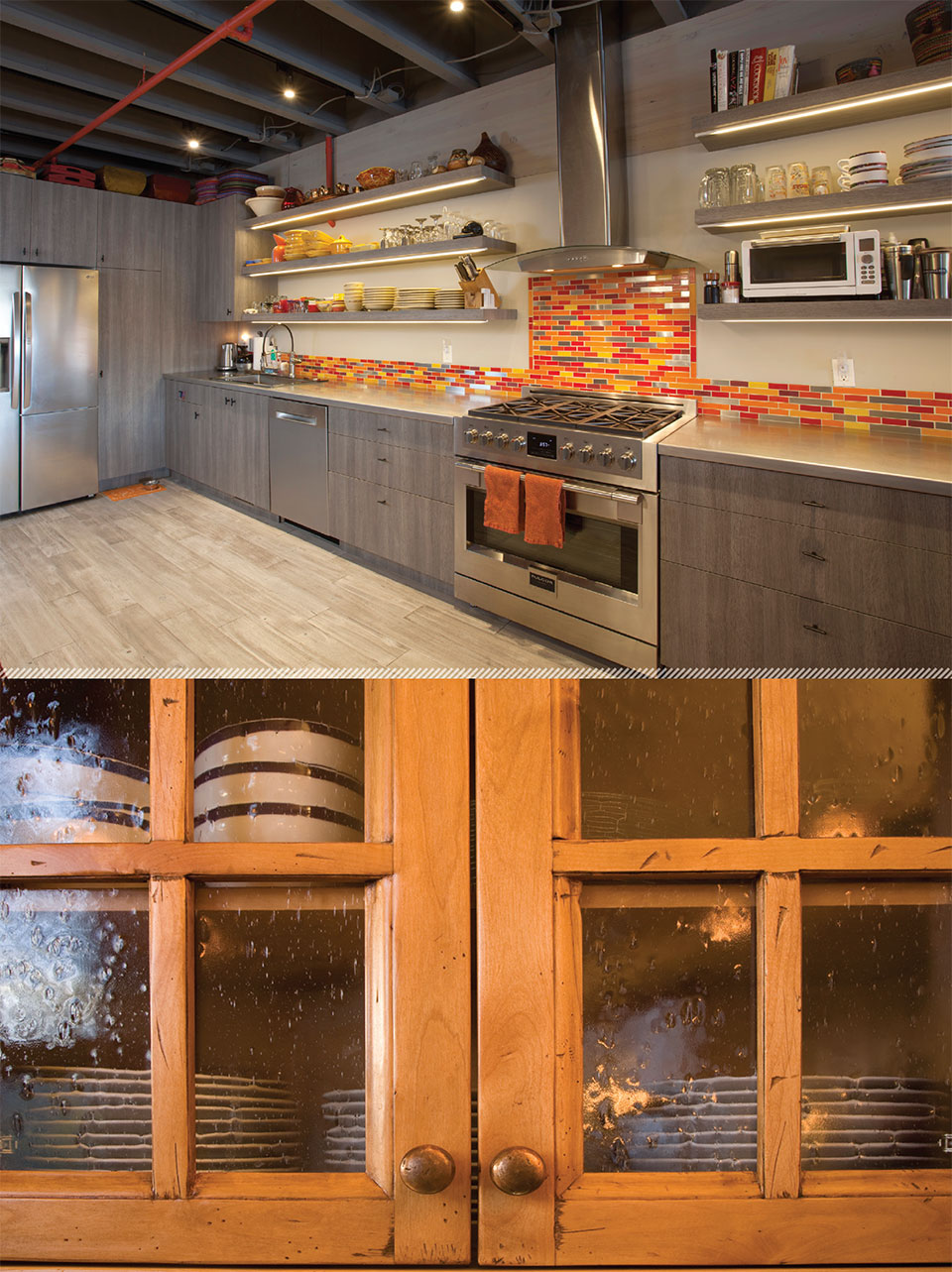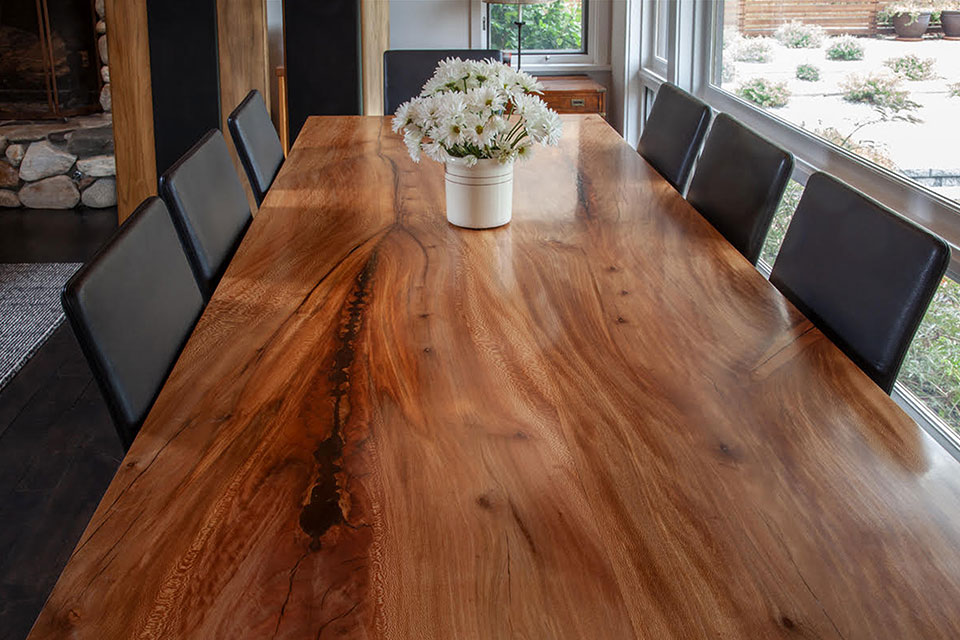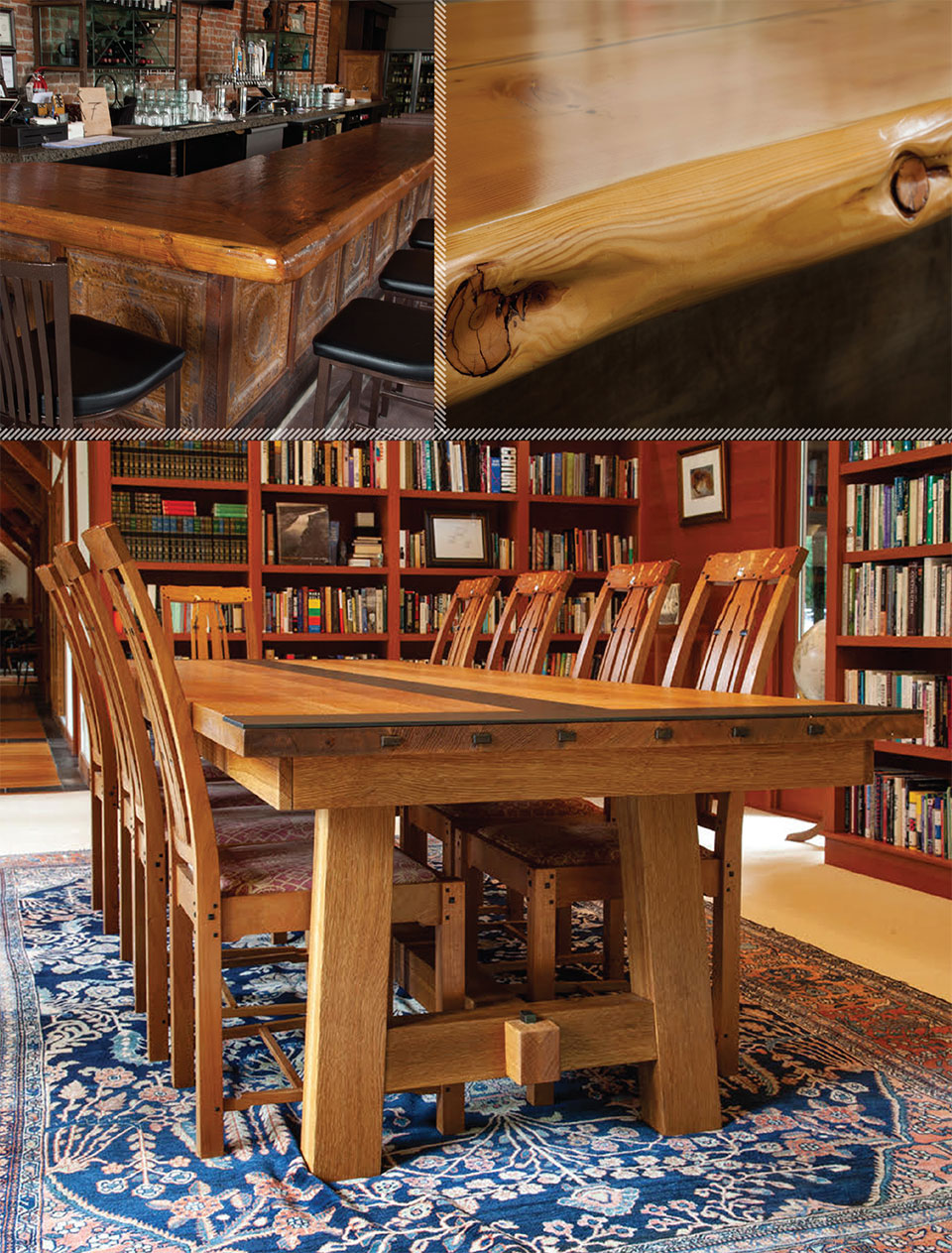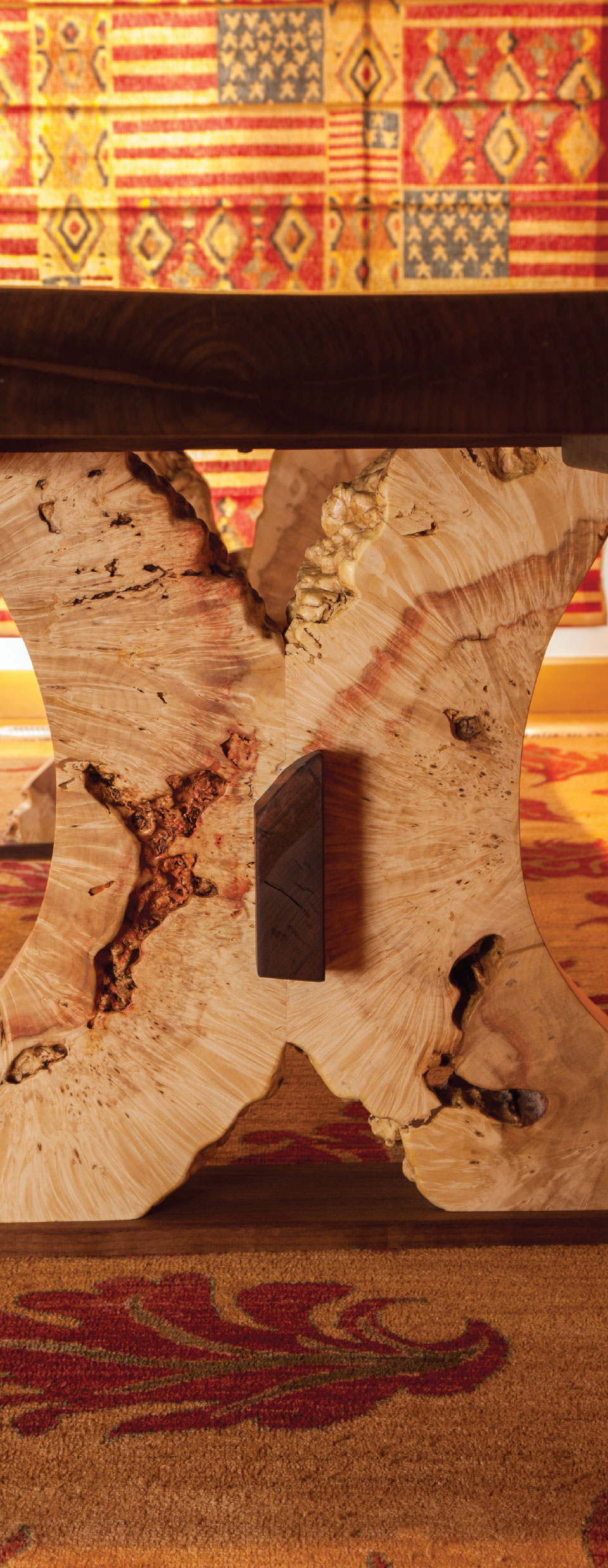BY Stephanie Dennee
Wood is one of the oldest building materials in human history. From the first huts and human tools to contemporary design’s most prized creations, wood, as a material, is at the center. The appeal of timber products, in all their potential variations, endures today. A well-crafted wood piece lends timeless warmth and beauty to the heart of a home. From structural elements to fine furnishings to artisan details, Western Home Journal spotlights how expert local craftsmen create with a medium that continues to take on new and relevant forms in our modern lives.
Guided by the Grain
Taylor Woodworks
“Pioneers moving to Idaho brought black walnut and planted it around their homesteads, So while it’s not indigenous to the area, it has a place in the history of Idaho.”
–Scott Taylor, Taylor Woodworks
When pressed on the subject, Scott Taylor will admit to having a favorite wood, though it’s clear that he admires all types. He’ll say that black walnut is his wood of choice, which isn’t necessarily unusual for a woodworker. Craftsmen revere the species for its variation in color and figuring in the grain. For Scott, the admiration goes beyond the physical characteristics of the wood and into the life of the tree. “Pioneers moving to Idaho brought black walnut and planted it around their homesteads,” he explains. “So while it’s not indigenous to the area, it has a place in the history of Idaho.” Today, many of those trees are reaching the natural end of their lives, or need to be harvested for one reason or another. Scott and his team at Taylor Woodworks are called by the great-great-grandchildren of those first homesteaders to cut and mill the trees that symbolize their legacy. “I’m thankful to be trusted to honor the heritage of those families by giving their trees a new life.”
For over 20 years, Taylor Woodworks has given new life to trees through their custom cabinetry, furniture, and architectural details. It’s a profession that Scott views as equal parts optimism and sleeves-up hard work. Optimism, in the sense that he feels his craft is a conduit for timber that might otherwise be unloved; an opportunity to do right by a great piece of wood. A buzzing workshop and lumberyard in Hailey, where Scott and his team of 13 people manage every step of the process, from milling to installation, is evidence of the hard work.
“We try to honor the life and the essence of the timber. It’s our goal to use it completely and in its most organic form.”
–Scott Taylor, Taylor Woodworks
“Cabinetry and furniture have always gone hand in hand for us,” says Scott. The cabinetry side of Taylor Woodworks anchors the business, keeping them busy with installations in both residential and commercial spaces, using material that can range from rustic reclaimed to high-shine veneers. Scott and his team work in concert with architects, designers, and homeowners to transfer their vision for cabinetry into workable concepts. Sometimes, a client will give Scott a sketch on the back of a piece of scrap paper as a start. Other clients specify every detail down to the screws. In either case, Taylor Woodworks adds their design talents to the mix. As Scott explains, “For us to fabricate the best product, we take our clients’ intents for design and interpret them into detailed cabinetry plans. Through that process, we are able to refine both the style and functionality of the cabinetry with them.”
On the furniture side, the craftsmen at Taylor Woodworks express themselves through work that features both detailed joinery and open, organic forms. Large slabs of live edge hardwoods are central to many of their recent custom pieces. The Taylor Woodworks yard is where this work originates. A selection of milled lumber, stacked in boule form (in order of sawing), sits there to air dry for two years before being kiln-finished and brought into the supply of the craftsmen.
For furniture pieces, clients have the opportunity to preview slabs and see what speaks to them personally. Scott can also act as matchmaker, marrying what he knows about wood with what he knows about the client or project. A maxim for Scott and his team is to work with the slab in its most authentic state. He explains, “I don’t see flaws in wood. I look at checking, cracking, and pith centers as expressions of the tree.” He works those expressions into the design, often featuring them with the addition of butterfly joints in contrasting materials that add integrity to the design. “We try to honor the life and the essence of the timber. It’s our goal to use it completely and in its most organic form.” The result is the transformation of a tree into beautiful custom pieces that have a soul all their own.
Tradition & Trendsetting
Conrad Brothers Construction
“So many elements of our work are done in wood. We build some homes that are almost entirely wood of various forms, inside and out.”
–Paul Conrad, Conrad Brothers Construction
In home building, wood can take many forms: the bones, the finished materials, and the compelling details. For Conrad Brothers Construction, wood encompasses all of these trade specialties and is an ever-evolving player in the firm’s creation of beautiful spaces. Paul Conrad, the company’s founder, says, “So many elements of our work are done in wood. We build some homes that are almost entirely wood of various forms, inside and out. We recently completed a home with Janet Jarvis that is reclaimed wood in and out with virtually no surface left unclad. That much old wood is a powerful palette. In other homes, wood may be just one of a number of elements, but it always plays an important role in the design of the home.”
The tradition of building is in Paul’s DNA. He pounded his first nails on the job sites of the third-generation family business in Virginia, then moved West, to California’s Humboldt County, where his appreciation for fine woodworking grew. “I worked a six-foot-tall vertical circular saw to mill fallen redwoods and built a home almost entirely out of redwood there. The melding of that experience with my family’s heritage in commercial construction is who I am today,” Paul says. This range of work is shown in the mix of Conrad Brothers’ large-scale commercial projects and many high-end residential projects throughout the Sun Valley area.
Conrad Brothers is fortunate to work with some of the best architects and designers in the industry. “Our collaboration with talented design professionals moves the process forward. Their eye for detail combined with our knowledge of wood nets some fantastic work,” says Paul. “We build relationships first. Then it becomes about building new ideas together, and having fun.”
Paul sees wood as serving multiple functions in the design of a home. “For some homes, wood is a central material that ties spaces together,” he says. At a recent project, a home designed by architect Gretchen Wagner for horse-lovers tucked into the foothills near Hailey, wood provides a continuum. Paul explains, “On this property, a traditional barn structure and a home with very contemporary lines needed to relate to each other. Cladding both buildings in barn board successfully binds the two styles together.”
“It’s an undeniable sensation when you see a great piece of wood. You can actually feel the life in it, and the work that went into making it.”
–Paul Conrad, Conrad Brothers Construction
In another approach, timber products provide clients with singular jaw-dropping details. For a Sun Valley area home, massive timbers are the standout in a neutral palette. “We had to procure four-foot-diameter western red cedar logs,” says Paul. “To find them, I went to British Columbia and walked a floating boom to hand-pick each one off the island of Victoria. Then we had to schedule a kiln big enough to dry them (there were only two in the country), and a craftsman skilled enough to taper-turn a piece of wood that large on a lathe. They are the most unique pieces of wood I may ever see in my career.”
Unique woodworking techniques can be seen throughout the portfolio of Conrad’s projects. For one home, a wall at the end of a hallway is finished in rough bark. But, with the touch of a hand, the bark reveals itself as a hidden door to a whiskey tasting room dressed with refined cabinetry. In another project, rustic reclaimed wood panels on a dining room wall are backed by a mirror, allowing the spaces between the wood to catch light and second looks from guests. Paul says of this dichotomy in materials, “Playing with the contrast between two materials, and the way one interacts with another, can lend unexpected moments to a home.”
Paul credits both designers and talented craftsmen for the evolving trends he sees in woodworking. “In addition to managing our crew of over 50 people, we fold in the Valley’s best specialty talent to our projects. It’s great to steer skilled craftsmen with so many engaging ideas, and see them come to fruition in our projects,” he says. Evidence of this is seen in the soon-to-be-reopened iconic Mint Bar in downtown Hailey. It will have many custom wood elements, including a massive live-edge slab of Idaho ponderosa, a collaboration between Conrad and Taylor Woodworks. What Paul says about this slab echoes his appreciation for woodworking as a whole: “It’s an undeniable sensation when you see a great piece of wood. You can actually feel the life in it, and the work that went into making it.”
Playing with Balance
Walsworth Furnishings
It was a pile of retired wine barrels on a vineyard, where he worked in Australia, that ultimately sparked his career in furniture making. “Seeing the purple pigment left inside and their distressed exterior, as well as the curve of the wood, was what started it for me.”
–Wes Walsworth, Walsworth Furnishings
The path Wes Walsworth takes to his downtown Ketchum woodworking shop, adjacent to his home, is short in physical distance but long in experience. It winds through a career in music and his years spent working at vineyards in Australia. Each of these pieces of his past seems to have informed the next, eventually leading the Sun Valley native to boomerang back to Idaho in order to refine his craft.
Wes’ roots are in music. He recorded and toured professionally for years, and crafted acoustic guitars for Taylor Guitars in California for a time. But it was a pile of retired wine barrels on a vineyard where he worked in Australia that ultimately sparked his career in furniture making. He recalls his first interaction with those forgotten barrels, “Seeing the purple pigment left inside and their distressed exterior, as well as the curve of the wood, was what started it for me.”
When Wes moved back stateside in 2010, he brought the woodworking skills he gained at both Taylor Guitars and from his father, a Sun Valley custom home builder by trade, and also drew inspiration from the patina and curve of those barrels he found in Australia. From there, Wes began creating rustic modern furniture, with the natural lines of spent barrels lending grace and ergonomic contour that belie the rustic character of the material.
The current trend of Walsworth Furnishings’ work moves the needle from rustic reclaimed wood to fine hardwoods, but Wes still holds a deep appreciation for the previous life that each piece of reclaimed wood brings to his shop. A stack of wine barrel pieces sits in his curing shed, and he is friendly enough with each of them to guess at the varietal they might have held in their previous life based solely upon their stain of red or the aroma they release when cut.
In many of Walsworth’s current pieces, the interplay between wood and steel defines his style. “I like the contrast between the two materials,” Wes says. “Putting polished steel up against rustic wood, or vice versa, really amplifies the beauty of both.” He plays with new techniques like steel and wood joinery, and creates sculptural forms like his cut steel drawer pulls that are still functional to the furniture piece. Scattered around his workshop are the components of an expandable reclaimed oak and ash dining table with lines that evoke mid-century styling while still retaining a mountain character through his choice of materials, and finishes that include steel edging and leg brackets.
“I view the natural integrity of the wood as most important, and try to do what I can with the finish while not taking away from the wood’s innate beauty.”
–Wes Walsworth, Walsworth Furnishings
The workshop is as much a laboratory as a space dedicated to creation. Wes uses it to experiment with the patina of steel, and with wood finishes like a combination of wool and vinegar, which reacts with tannins in the wood to blacken oak and walnut. While these trials push his design forward, he ultimately strives to find a balance between the finish and preservation of a wood’s natural character. “I view the natural integrity of the wood as most important, and try to do what I can with the finish while not taking away from the wood’s innate beauty.”
Wes strikes a similar balance in his design concepts, which continue to move where his artistic vision takes him, while always remaining somehow versed in a mountain aesthetic. This is perhaps because, though he sells his work nationwide online, putting Walsworth furniture in almost every state of the union, he still views the custom work he does for the Sun Valley area as central to his business.
Focused Fabrication
Taft Design Works
“We want to design cabinets that suit our clients’ lifestyles. That starts with understanding how they will use it.”
–Jim Taft, Taft Design Works
Experience in woodworking is gained board by board, year after year. Jim Taft, with 42 years spent in the building industry, has developed a wide breadth of knowledge, and the desire to work directly with wood has always been at the center. Jim says, “I started as a carpenter, then moved into general contracting for years. But I always loved woodworking. Building cabinetry was a natural progression, a way to incorporate woodworking and make sure I was putting the best products into the homes I built.” Taft realized over time that cabinetry fabrication was the area he wanted to focus on. That specialization now makes Taft Design Works a leader in custom cabinetry in the Sun Valley area, offering a wide range of products and styles, all guided by Jim’s wealth of expertise.
Kitchens are the center of a home and at the center of Taft Design Works’ portfolio. While Jim is hands-on in all parts of the business, managing both the shop and installation team, he says that his primary role is in understanding customers’ desires. Through consultation and careful measurement, Jim designs and drafts kitchen cabinetry to perfectly fit each client’s needs, beginning with a conversation about how the kitchen will be used. “We want to design cabinets that suit our clients’ lifestyles. That starts with understanding how they will use it. If they are accomplished home chefs, or only use their kitchen to make coffee, that information can help us give them the most functional space,” Jim explains.
Beyond the functionality of cabinetry, Jim works to understand how the style of cabinets will fit within the broader context of the home design, saying, “I visit sites or look at the entire set of house plans to see what the architect and homeowner are trying to achieve with the overall design. Doing that helps narrow the scope of products, and I can show them a range of materials that speak to their style sensibilities.”
The range of materials and styles available through Taft Design Works is nearly endless. In addition to their custom work in veneer, reclaimed, and hardwood cabinetry, Taft has added two pre-finished cabinetry lines and quartz countertop products to their showroom in Bellevue. He says that pre-finished cabinetry options are adaptable to a variety of kitchen spaces, providing a cost-effective, quality solution for their customers.
“We do hardwood Shaker-style cabinets with complex glaze finishes. On the other hand, we also see a lot of desire for the clean look of veneers, and the rustic look of reclaimed cabinetry continues to be a popular style for mountain homes.”
–Jim Taft, Taft Design Works
Over the years, Jim has seen a full arc of cabinetry trends and appreciates the wide variety of styles used throughout the Valley. He says, “We do hardwood Shaker-style cabinets with complex glaze finishes. On the other hand, we also see a lot of desire for the clean look of veneers, and the rustic look of reclaimed cabinetry continues to be a popular style for mountain homes.” The Taft Design team works to make sure the desired cabinet look matches the expectations of their clients. Jim’s experience shines here, and he knows first-hand how different styles of cabinets hold up to different types of use, and what material best fits the function.
Beyond kitchens, Taft Design Works fabricates a wide range of cabinetry and architectural installations for every room of the home. Bathrooms, bars, office and entertainment centers, and integrated bunk beds all find their way to the Taft shop, one project often leading to the next. “We see a lot of repeat work,” Taft says. “Clients use us for one room, and then they come back again for a different area of the home. I think that says a lot about the reputation we’ve built.”
With all the time Jim spends designing layouts and managing Taft Design Works, he finds himself still craving the tactile challenge of woodworking that first brought him into the business. He feeds that desire with custom boat building. Over the years he has built a handful of drift boats, bending and finishing the wood in the evenings and on weekends. He says it challenges him—boat building is considered among the most complicated specialities of woodworking. “It’s good to stay hands-on in the trade, and I like for my team to see that I know what expert craftsmanship is,” Jim says. That keen eye for quality translates directly into all of Taft Design Works’ products.
Ahead of the Curve
Randall Edgar Fine Wood Working
“I do all types of woodwork, But burled, abstract timber forms are my favorite.”
–Randy Edgar, Randall Edgar Fine Woodworking
The woodworking industry, generally speaking, trends toward the level and linear. The act of fabricating a functional piece is easier when a straight edge is involved. But Randy “Rando” Edgar has never been known to take the easy route. Rando works in curves. “I do all types of woodwork,” he says. “But burled, abstract timber forms are my favorite. I can look at each piece, and the wood will tell me where to put it. It becomes a collage process, fitting warped shapes together to create something both beautiful and usable.”
He explains this as he stands next to a dining room console with Molesworth detailing and birch bark inlays that he’s just finished. This classic western style is one that Randy has worked with regularly over the years. The console’s legs are new to his repertoire though. Stained a deep burgundy, they are the truly striking, sculpted feature of the piece. “These are from a 75-year-old Chardonnay vine from the Napa area,” Randy says, running a hand over the sinewy, curved ridges of the old vine, sanded and stained to an elegant finish.
The organic shapes Randy works with are an apt reflection of his personality: true authenticity, meandering from one interesting story to the next. As for his unique ability to fit misshapen timbers into his custom pieces, he credits a touch of dyslexia, which he says has served him well in solving design problems. “I think dyslexia has given me the ability to see things three-dimensionally. I can just put things together in my mind. When I see a crazy piece of wood, I know exactly what it can be.”
Randy is known for creating bars and tables in burl wood with a distinctly western flair, as well as classic and contemporary styles. He enjoys the niche in bars and tables, saying, “They are well-used, and I love building functional art. And a table or bar is where the good stuff happens for a family, friends, a community. It’s great for my pieces to be a part of that.”
“I might have a bit of a wood hoarding problem, But let’s just call it curated.”
–Randy Edgar, Randall Edgar Fine Woodworking
His latest table pieces include collaborations with local artists Janet Starr and Deb Rosen, who helped him design a dining table in sycamore slab—two large pieces, bookended and glued on the curve, with steel details and a maple base. “Sycamore is a beautiful wood, but not often worked with because it’s difficult to manage the lacy grain. It couldn’t be planed because of the grain pattern, so I sanded it by hand,” he says. On the other end of the design spectrum is a bird’s-eye maple slab table with a high-gloss finish, the result of an enormous sugar maple’s shallow root system.
At Randy’s home and workshop (he built both) on the banks of the Big Wood River are stacks, bundles, great heaps of his raw wood collections—everywhere. “I might have a bit of a wood hoarding problem,” he jokes. “But let’s just call it curated.” He has foraged the timber on long walks in the surrounding forests, and through friendships across the West. He gives a show and tell of grapevine, massive maple stumps, and Idaho fir.
One large bristlecone pine leaning against his shop wall, limbs still stretching from the deformed trunk, is particularly interesting. It was harvested from the Twin Peaks area at about 11,000 feet, an altitude where life is precarious and growth is slow. Randy estimates that the tree was about 1,000 years old when it finally died off. It was struck by lightning some hundreds of years ago, killing all but a small portion of the tree. The sapling that remained then grew from the base of the tree, twisting around the gray death of the central trunk, snaking up and around its mother in search of more light.
The tree is still searching. Randy has held onto it for 20 years, waiting for the right project. “It’s so unique, and I know not everyone will be able to see it and have a vision for what it can be.” Randy does, though. He envisions stairs built around it, mimicking the curve of the tree’s long life. He sees, in three dimensions, how it will come together, and what it can be.

